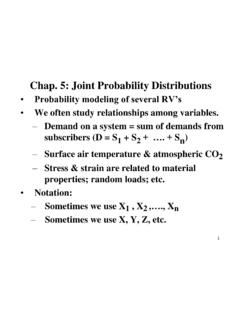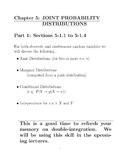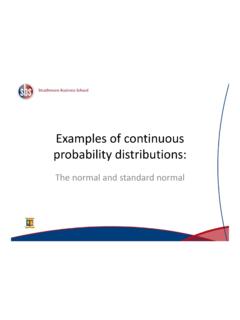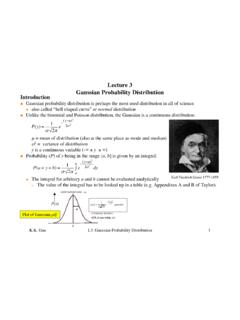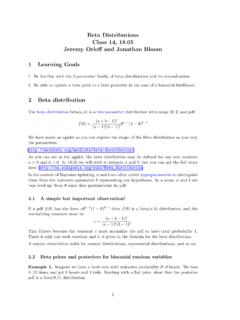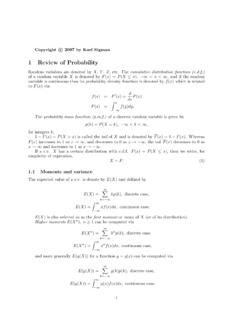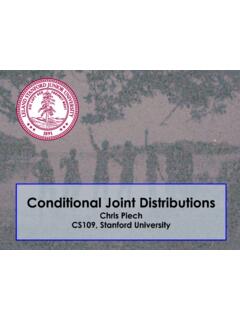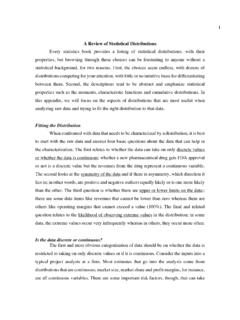Transcription of Level 3 Comp Probability - Glasgow Caledonian University
1 1 Probability and Probability Distributions 1. Introduction 2. Probability 3. Basic rules of Probability 4. Complementary events 5. Addition Law for Compound Events: A or B 6. Multiplication Law for Compound Events: A and B 7. Bayes Theorem 8. Tree Diagrams 9. Problems on Probability 10. Probability Distributions 11. Discrete Probability Distributions 12. The Expected value and Variance of a Discrete Probability distribution 13.
2 The Binomial distribution 14. The Poisson distribution 15. Continuous Probability Distributions 16. The Normal distribution 17. Using Statistical Tables to Calculate Normal Probabilities 18. Worked Examples on the Normal distribution 19. Problems on the Standard Normal distribution 20. Problems on the Normal distribution (General) SCHOOL OF ENGINEERING & BUILT ENVIRONMENT Mathematics 2 Probability and Probability Distributions 1 Introduction In life there is no certainty about what will happen in the future but decisions still have to be taken.
3 Therefore, decision processes must be able to deal with the problems of uncertainty. Uncertainty creates risk and this risk must be analysed. Both qualitative and quantitative techniques for modelling uncertainty exist. In many situations large amounts of numerical data is available which requires statistical techniques for analysis. Quantitative modelling of uncertainty uses a branch of mathematics called Probability . This chapter introduces the concepts of Probability and Probability distributions. The application of statistical methods is very extensive and is used in all branches of Science and Technology, Industry, Business, Finance, Economics, Sociology, Psychology, Education, Medicine etc.
4 Examples of Scenarios Involving Uncertainty In the following examples consider elements of uncertainty involved: A production scenario [costs and availability of raw materials, labour, production equipment; demand for product etc] Aircraft design [reliability of components, systems, safety issues etc] Financial Investment [interest rates, markets, economic issues etc] Development of a new drug [reliability, trials etc] Statistics is sometimes described as the science of decision making under uncertainty and can be divided into two broad areas as follows: Descriptive Statistics which includes the organisation of data, the graphical presentation of data (pie charts, bar charts, histograms etc) and the evaluation of appropriate summary statistics (measures of average the arithmetic mean and measures of spread standard deviation).
5 Descriptive statistics are the first step in analysing data and always precedes inferential statistics but can be, depending on the type of study, the only way to analyse collected data. Inferential Statistics which covers those statistical procedures used to help draw conclusions or inferences about a population on the basis of a sample of data collected from the population. Sampling is necessary because measuring every member of a population is time-consuming and expensive, impractical or impossible. Important areas inferential statistics include confidence intervals, hypothesis tests, regression analysis and experimental design.
6 Underlying inferential statistics is the idea of Probability and Probability distributions. 3 Some Terminology It is important, when dealing with data, to have an understanding of the terms used. Some are given below. Random Variable Data may come from a survey, a questionnaire or from an experiment. The "quantity" being measured or observed is referred to as a random variable as it may vary from individual to individual, heights of University students. It is commonly denoted by a symbol such as x. There are two types of random variable: qualitative and quantitative. Qualitative Variables These variables cannot be determined numerically and are usually measured categorically.
7 Examples include hair colour, blood group, marital status, gender. Quantitative Variables These variables can be determined numerically which allows comparison between values on the basis of magnitude. Examples include height of University students, daily temperature, daily /Euro exchange rate. Such variables can be further split into: discrete where the variable can take only values which differ among themselves by certain fixed amounts, usually integers ( counts such as daily number of breakages of cups in a refectory) continuous where the variable can take any value within a given range ( temperature at midday on a series of days).
8 Population A population is the entire group of units, individuals or objects from which data concerning particular characteristics are collected or observed. Generally, it is impractical to observe the entire group, especially if it is large, and a representative part of the population called a sample is usually considered. Sample A sample is a representative collection of observations taken form the population. A random sample is a sample selected in such a way that each member of a population has an equal chance of being included in the sample. 4 2 Probability The idea of Probability is familiar from games of chance such as card games.
9 Definition of Probability If an experiment is performed a large number of times (say, N), and the number of times that a particular event A occurs is counted (say n), we define: Probability of event A occurring, denoted by P (A) = NnN lim. In other words, the Probability that the event A occurs in any one performance of the experiment, is defined to be the limiting value of the proportion of times that A would occur if the number of repetitions of the experiment tended to infinity. For example, consider the experiment of tossing a fair coin. The set of possible outcomes for this experiment is {H, T}, the letter H representing the simple event Heads , and T representing Tails.
10 According to this definition we would assign equal Probability of to each of these outcomes, because, in a large number of tosses, heads and tails turn up an approximately equal number of times. If an experiment has n equally likely outcomes, r of which produce the event A then P(A) = outcomes ofnumber A give which outcomes of totalnumber = nr For example, consider the standard pack of 52 playing cards and an experiment defined by drawing a card from a well-shuffled pack. According to this definition, there are 52 possible outcomes to this experiment, and, if the shuffling is done thoroughly, it seems reasonable to regard them as equally likely.



